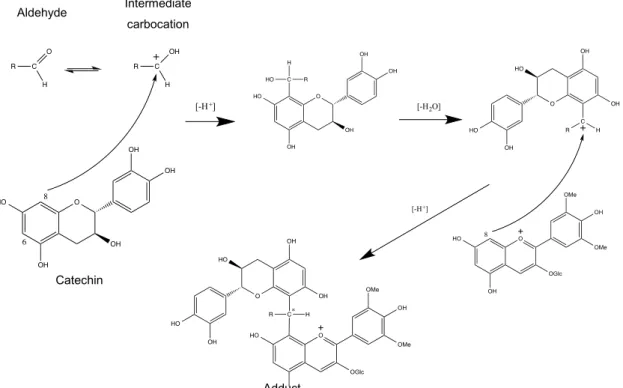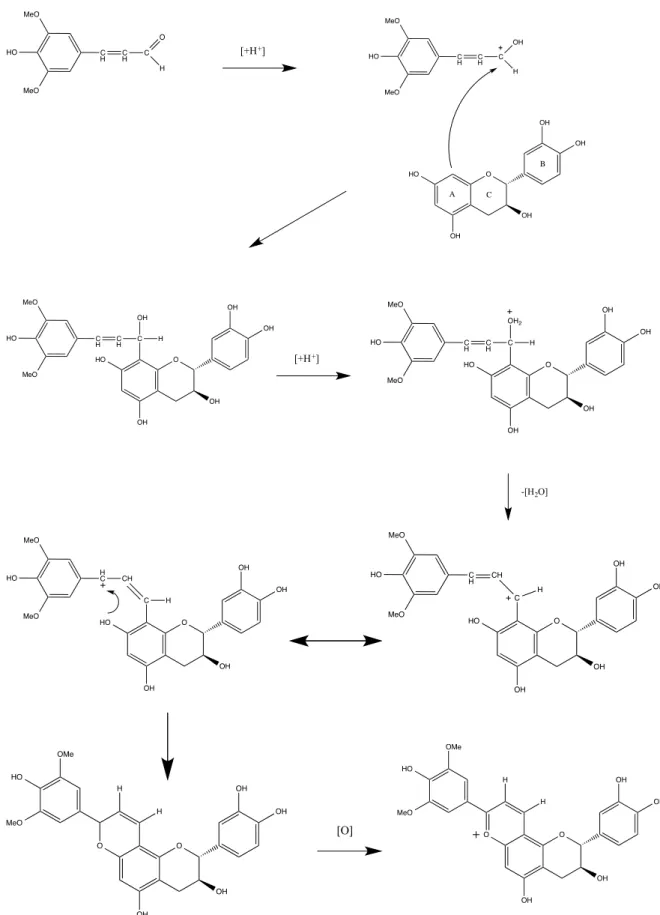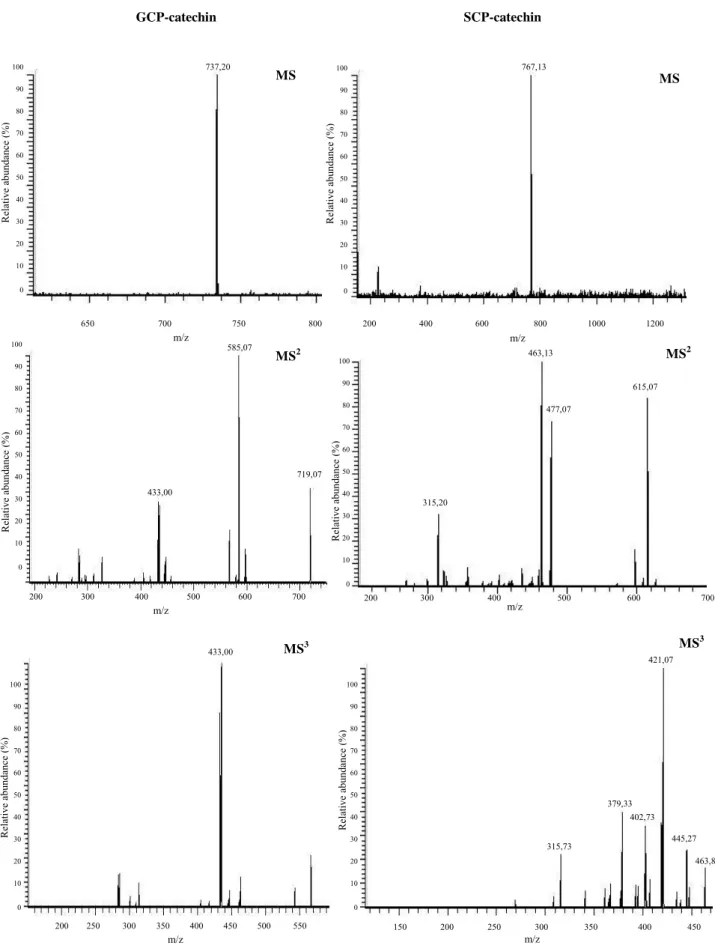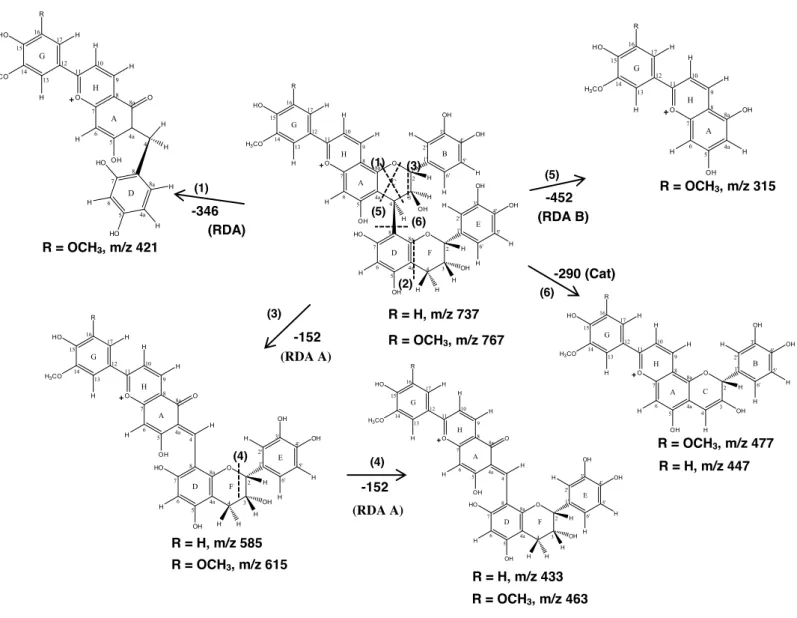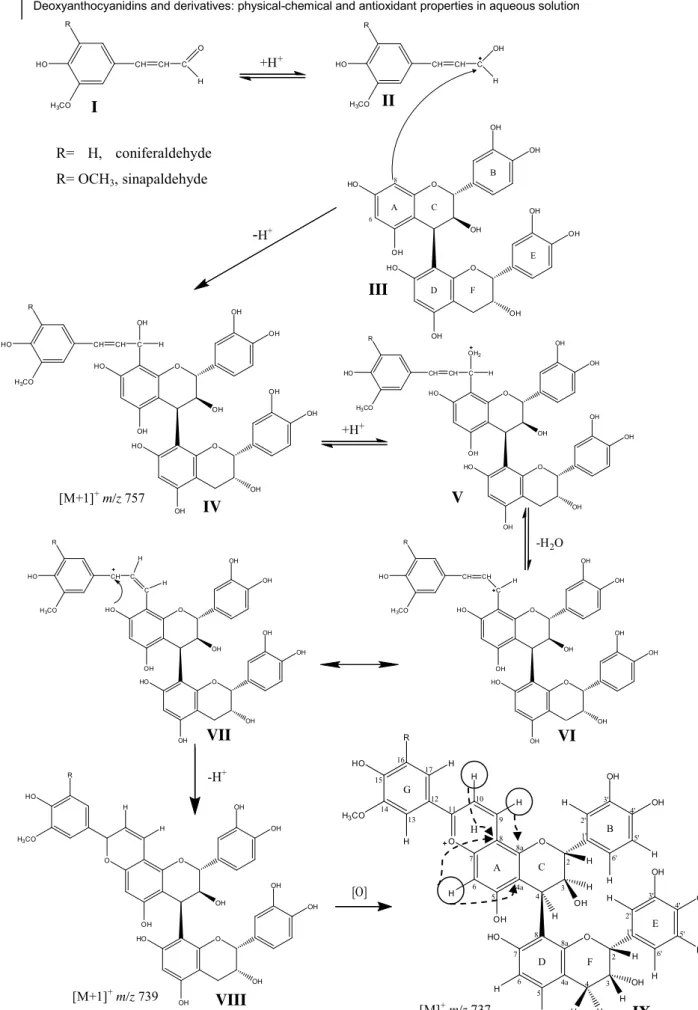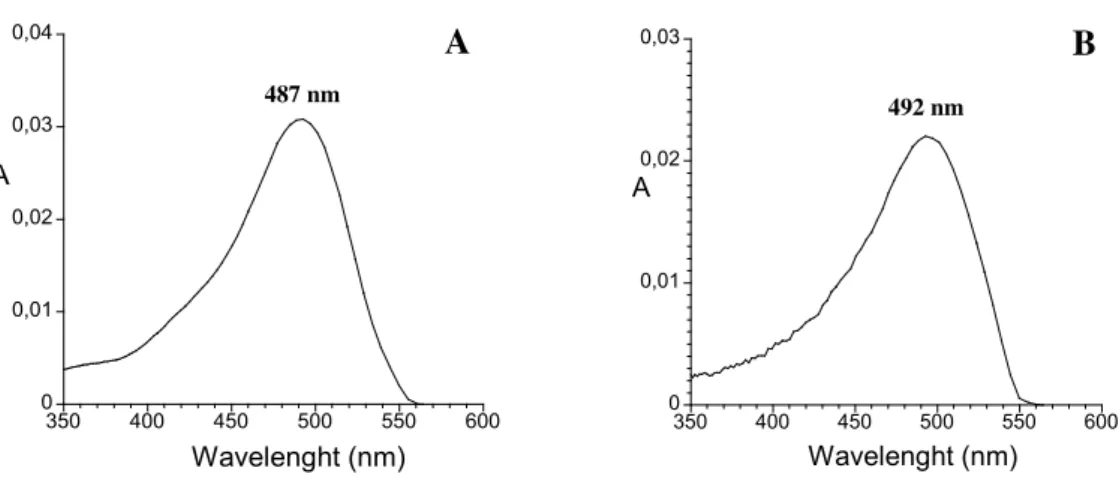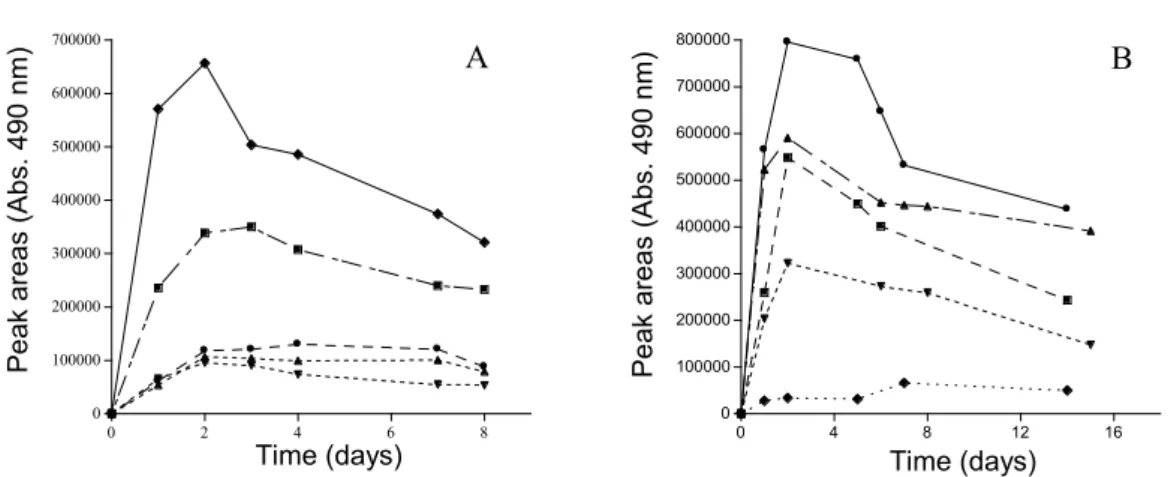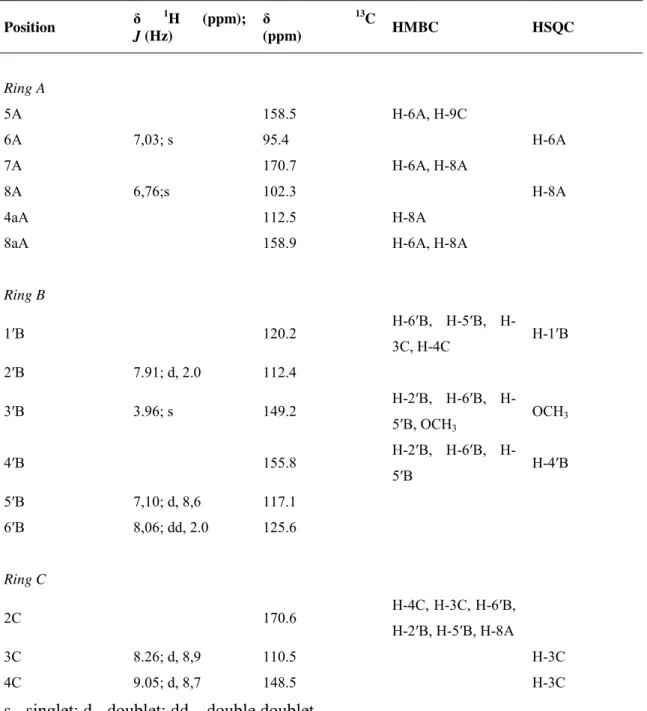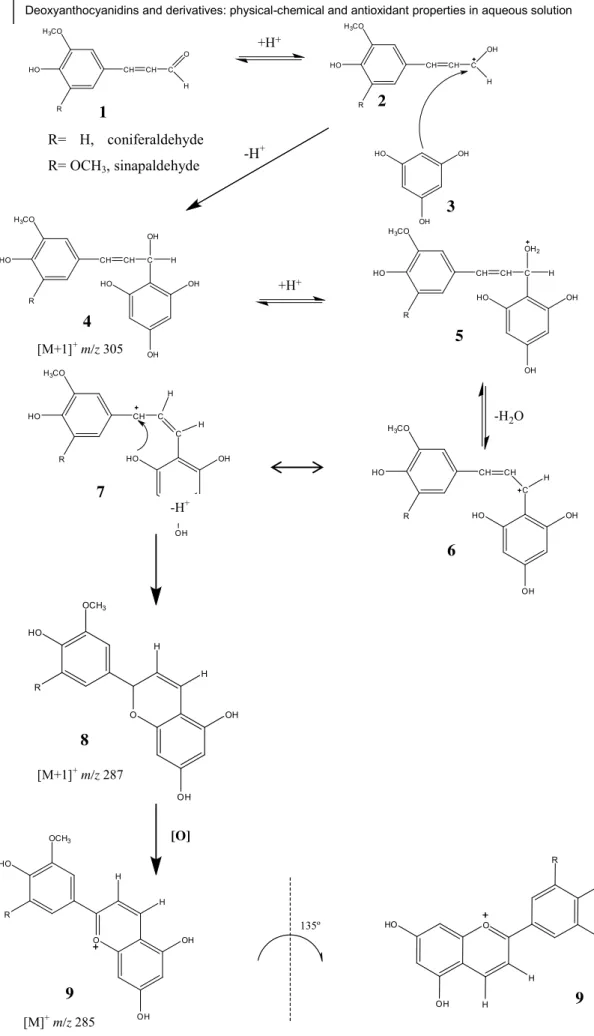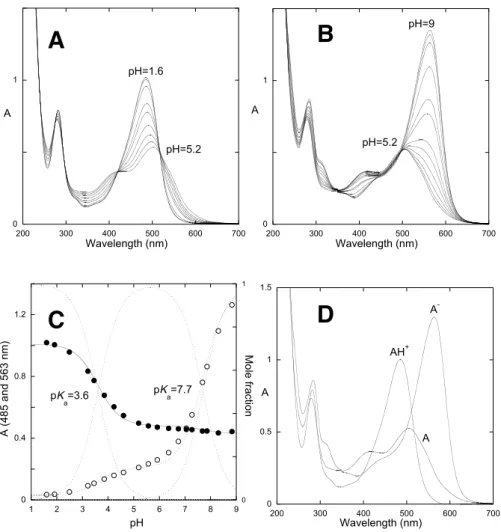Deoxyanthocyanidins
and derivatives:
physical-chemical
and antioxidant
properties in
aqueous solution
André Manuel Alves de Sousa
Programa Doutoral em Química Departamento de Química e Bioquímica 2015
Orientador
Victor de Freitas, Professor Catedrático,
Faculdade de Ciências da Universidade do Porto
Coorientador
Nuno Mateus, Professor Associado com Agregação, Faculdade de Ciências da Universidade do Porto
eressado, que a tal se compromete.
This work was possible thanks to FCT (Fundação para a Ciência e Tecnologia) for a PhD grant (ref. SFRH/BD/68736/2010) and a research grant (PTDC/QUI-QUI/117996/2010). Financial support was conceded to work in another institution (Faculty of Sciences and Technology, New University of Lisbon) as well as funding to international conferences.
Studies presented in this dissertation were performed in the Chemistry and Biochemistry Department of Faculty of Sciences, University of Porto, in the Group of Food Chemistry (line 2) and in the Group of Physical Chemistry of Faculty of Sciences and Technology, New University of Lisbon.
“Only those who attempt the absurd can achieve the impossible.” – Albert Einstein
Agradecimentos
. Desta forma gostaria de expressar o meu sincero agradecimento:
Ao meu orientador Professor Doutor Victor Freitas, sem o qual este tra teria sido . Obrigado pela oportunidade que me deu de trabalhar num grupo de excelência e pelo contributo que teve no meu crescimento científico, de investigação e pessoal.
Ao meu co-orientador Professor Doutor Nuno Mateus, sempre disponível, interessado e bem-disposto.
que me proporcionaram, os professores representarão sempre as minhas referências máximas de formação.
da Faculdade de Ciências e Tecnologia da Universidade Nova de Lisboa, em particular ao Professor Doutor Fernando Pina e ao Doutor Vesselin Petrov. Duas das mentes mais brilhantes que alguma vez tive o prazer de conhecer. O estágio que realizei neste grupo foi sem dúvida uma experiência extremamente enriquecedora. . . (SFRH/BD/68736/2010) e do projeto no qual este trabalho se encontra inserido, PTDC/QUI-QUI/117996/2010.
2 do Centro de Faculdade de Ciências, nomeadamente à Dra. Zélia pela ajuda técnica nas análises de LC-MS e à Mariana pela disponibilidade e apoio na realização de análises de RMN.
Em especial, aos meus a , o Frederico, a Elsa, a Joana Azevedo, a Joana Oliveira, o Luís, a Mara, a Natércia Brás, Teixeira, a Paulinha, o Rui, a Susana, a Vanda , e ensinarem.
Aos meus amigos Alfredo, João, Hugo, Miguel, Pedro e Sócio. Aqueles que estão sempre presentes para tudo e para nada. Ao Cebadas, que apesar de já não estar cá, estará sempre conosco.
Aos meus amigos e pessoal da Iterar, Alves, Jony e Craveiro. Tem sido uma enorme aventura e um prazer trabalhar e aparvalhar convosco todos os dias. Vocês são loucos e incríveis ao mesmo tempo! i = 0 ; < +∞; ++.
Aos meus pais , o orgulho que sempre sentiram em mim. Aos meus avós que sempre me trataram como um filho e me ajudaram sempre mais do que o que podiam. Obrigado também ao resto da família por todo o carinho e apoio que sempre tiveram comigo.
Uma palavra especial à Esmeralda pela partilha e amor incondicional de todos estes anos. Por estares sempre ao meu lado, tanto nos momentos de alegria como naqueles em que tudo parece desabar. Não há nada que possa descrever a felicidade que tenho em percorrermos esta aventura juntos.
Resumo
Os polifenóis assumem um papel importante em matrizes alimentares, nomeadamente em vinhos, contribuindo directamente para as propriedades organolépticas, como a cor e o sabor. Alguns destes compostos, como as antocianinas e seus derivados apresentam cores intensas e são relativamente estáveis em solução aquosa. Esta característica confere a estes compostos a potencialidade de serem usados como corantes alimentares comerciais, o que tem conduzido consequentemente a avanços na pesquisa desenvolvida sobre a sua química ao longo dos anos.
O objectivo deste projecto foi de investigar e estudar pigmentos com características de cor e estabilidade interessantes em solução aquosa que possam ter potencial aplicação na indústria alimentar e de saúde, entre outras.
A estrutura química da forma de chalconas das antocianinas comuns é considerada muito importante em reações que conduzem à sua degradação irreversível, particularmente em soluções ácidas ou básicas fracas. No entanto, as desoxiantocianidas naturais são muito mais estáveis neste tipo de soluções do que as antocianinas e antocianidinas, conferindo-lhes a vantagem de serem usadas como corantes alimentares comerciais viáveis, justificando a investigação desenvolvida sobre a sua química, e em particular, a pesquisa por novos corantes com grande estabilidade. Além disso, outros estudos têm demonstrado outras potenciais aplicações para estes compostos, como o seu uso em tintas para cabelo, lasers, sensores de células fotovoltaicas e sistemas de memória molecular.
Sendo assim, vários pigmentos da família das desoxiantocianidinas foram sintetizados, isolados e estruturalmente caracterizados.
No primeiro trabalho foi estudada a reação entre procianidinas diméricas, que estão presentes em vinhos, e aldeídos cinâmicos que são extraídos de barricas de madeira durante o envelhecimento do vinho. Foi observada e confirmada a formação de novos pigmentos de cor laranja com uma estrutura em forma de aducto de oaklina-catequina. Estes aductos são classificados de desoxiantocianidinas, uma vez que não apresentam substituintes no carbono em posição meta comparativamente ao oxigénio com carga positiva do núcleo flavânico. O mecanismo hipotético de formação destes novos compostos foi elucidado e o aducto formado foi caracterizado estruturalmente por espectrometria de massa e RMN.
Foi descrita uma nova e simples síntese para obter 3-desoxiantocianidinas, nomeadamente a desoxipeonidina e a desoximalvidina, a partir da reação entre o floroglucinol e aldeídos cinâmicos (coniferaldeído e sinapaldeído).
A estabilidade de diferentes tipos de desoxiantocianidinas foi estudada por espectroscopia UV-Vis, comparando o seu comportamento e as suas propriedades fisico-químicas sob diferentes condições de pH e estímulo à luz com compostos análogos, como antocianinas comuns e outros flavílios.
Foram calculadas as constantes cinéticas e de equilíbrio da rede de reações químicas dependentes do pH e a sua fotoquímica foi avaliada.
Foi realizada a síntese de novos compostos análogos às piranoantocianinas (vitisinas). Os produtos resultantes foram designados de desoxivitisinas. A estabilidade da cor e a rede de reações químicas que ocorrem em solução aquosa após alterações de pH para estes compostos foi investigada aprofundadamente. As desoxivitisinas revelaram-se menos ácidas, e por conseguinte mais estáveis, que as correspondentes piranoantocianinas 3-O-glucosiladas.
Com um conhecimento profundo das propriedades das desoxiantocianidinas que advieram dos trabalhos anteriores, foi investigada a contribuição que outros efeitos poderiam ter nas propriedades da cor destes compostos. Assim, foram estudadas interações de copigmentação entre oaklinas (desoxiantocianidinas substituídas no anel A), que foram previamente identificadas em vinhos, com diversos copigmentos: catequina, epicatequina, ácido clorogénico, epigalhocatequina e a procianidina B3. Os resultados mostraram que as oaklinas, tal como as antocianinas, também apresentam interações de copigmentação que estabilizam ainda mais o catião flavílio em soluções hidroalcoólicas. Também foram realizadas simulações de dinâmica molecular para interpretar as ligações/interações químicas, especificando a posição relativa das moléculas do pigmento e copigmento nos complexos, e para interpretar as propriedades de absorção no visível dos complexos formados.
Por último, foram avaliadas as propriedades antioxidantes e antiproliferativas de várias desoxiantocianidinas através de métodos como o DPPH, FRAP, inibição da peroxidação de lipossomas e efeitos antiproliferativos em linhas celulares cancerígenas do estômago e do cólon. Os resultados mostraram que as desoxiantocianidinas apresentam propriedades antiradicalares, antioxidantes e antiproliferativas. Foi interessante observar que uma das desoxiantocianidinas, a oaklina guaiacilcatequinapirílio, apesar de apresentar menor capacidade antioxidante/antiradicalar nos ensaios de DPPH e FRAP quando comparada com a antocianina cianidina-3-glucósido, demonstrou um superior efeito antioxidante no modelo de lipossomas. O uso de lipossomas constitui um método promissor para avaliar propriedades antioxidantes relevantes para a nutrição humana, uma vez que usa uma membrana biológica. As oaklinas, que em estudos anteriores demonstraram ter propriedades interessantes quanto à sua cor e o seu uso em corantes
alimentares, devido à sua maior estabilidade em soluções de pH ácidas/neutras, também revelaram propriedades antioxidantes semelhantes às antocianinas comuns. Este projeto permitiu um avanço científico significativo no estudo de um tipo de compostos derivados de antocianidinas, designados por desoxiantocianidinas. Estes compostos foram previamente identificados e descritos, mas nunca houve um profundo e extensivo estudo sobre as suas propriedades.
PALAVRAS-CHAVE: antocianinas, desoxiantocianidinas, oaklinas, corantes alimentares, envelhecimento do vinho, rede de reações flavílio, fotoquímica, copigmentos, propriedades antioxidantes, espectroscopia UV-Vis, espectrometria de massa, RMN
Abstract
Polyphenols assume an important role in food matrixes and namely in wines, contributing directly to their organoleptic properties such as color and flavor. Some of these compounds, such as anthocyanins and derivatives present intense colors and are relatively stable in aqueous solutions. This feature has given them the potential advantage to act as viable commercial food colorants, which has consequently led to advances in the research developed in their chemistry over the years.
The purpose of this project was to investigate and study pigments with interesting color features and stability in aqueous solutions that could have potential applications in food, health and other industries.
Open chalcone forms of the common anthocyanins are assumed to be crucial in reactions leading to irreversible degradation of anthocyanins, particularly under weakly acidic to weakly alkaline solution conditions. However, the natural deoxyanthocyanidins are much more stable in slightly acidic solutions than anthocyanins and anthocyanidins, which points to the potential advantage of this type of compounds as viable commercial food colorants, and justifies the research developed in the chemistry of 3-deoxyanthocyanins and, in particular, the search for new colorants with significant stability. In addition, more studies have demonstrated other potential applications for these compounds, such as their use as hair dyes, laser dyes, sensitizers for solar cells, and molecular-level memory systems.
Bearing this, several new pigments of the family of deoxyanthocyanidins were synthesized, isolated and structurally characterized.
In the first work, the reaction between dimeric procyanidins, which are present in real wines, and cinnamic aldehydes which are extracted from wood barrels during wine aging was studied. The formation of new orange pigments that were oaklin-catechin adducts was observed and confirmed. These adducts are classified as deoxyanthocyanidins, since they are not substituted in the carbon in m-position to the positively charged oxygen of the flavylium core. The hypothetic mechanism of formation of these new pigments was elucidated and the adduct formed was structurally characterized by mass spectrometry and NMR.
A new and simple synthesis procedure to obtain 3-deoxyanthocyanidins, particularly deoxypeonidin and deoxymalvidin, from the reaction between phloroglucinol and cinnamic aldehydes (coniferaldehyde and sinapaldehyde) was described.
The stability of different types of deoxyanthocyanidins was investigated by UV-Vis spectroscopy, comparing their behaviour and physical-chemical properties under
different pH conditions and light stimulus with analogous compounds such as common anthocyanins and other flavyliums.
The rate and equilibrium constants of the respective pH dependent network of chemical reactions presented by these compounds were calculated and their photochemistry evaluated.
The synthesis of new compounds analogous to pyanoanthocyanins (visitins) was carried out. The resulting products were designated deoxyvitisins. The color stability and the network of chemical reactions occurring in aqueous solution upon pH variations for the newly synthesized deoxyvitisins were thourougly investigated. Deoxyvitisins were found to be less acidic, thus more stable, than the corresponding pyranoanthocyanin 3-O-glucosides.
With a deeper understanding of the physical-chemical properties of deoxyanthocyanidins provided by the previous works, it was investigated the contribution that other effects might have on color features of these compounds. Hence, copigmentation interactions were studied between oaklins (ring A substituted deoxyanthocyanidins), which have been previously identified in wines, and several copigments: catechin, epicatechin, chlorogenic acid, epigallocatechin, and procyanidin B3. The results showed that oaklins, like common anthocyanins, also present copigmentation interactions that further stabilize the flavylium cation in hydroalcoholic solutions. Molecular dynamic simulations were also performed to interpret the binding data, to specify the relative arrangement of the pigment and copigment molecules within the complexes, and to interpret their absorption properties in the visible range.
Finally, the antioxidant and antiproliferative properties of several deoxyanthocyanidins were evaluated by DPPH, FRAP, liposomes peroxidation inhibiton assays and antiproliferative effects against cancer cell lines from stomach and colon. The results showed that all the deoxyanthocyanidins tested demonstrated antiradicalar, antioxidant and antiproliferative properties. It was very interesting to observe that one of the deoxyanthocyanidins, the oaklin guaiacylcatechinpyrylium, despite showing lower antioxidant/antiradicalar capacity in DPPH and FRAP assays when compared to an anthocyanin (cyanidin-3-glucoside), revealed a surprising higher antioxidant effect in the liposomes model. The use of liposomes constitutes a more promising method for assessing antioxidant properties relevant to human nutrition, since it uses a model biological membrane. Oaklins, which were previously shown to have interesting color features for its use as food colorants, due to their higher color stability in acidic/neutral pH solutions, also revealed antioxidant properties similar to common anthocyanins.
This research has allowed a significative scientific advance in the study of a specific anthocyanidin derived type of coumpounds, named deoxyanthocyanidins. They have been previously identified and described but there has never been a profound and extensive study about their characteristics.
KEYWORDS: anthocyanins, deoxyanthocyanidins, oaklins, food colorants, wine aging, flavylium network reactions, photochemistry, copigments, antioxidante properties, UV-Vis spectroscopy, mass spectrometry, NMR
Table of Contents
Agradecimentos ... vii
Resumo ... xi
Abstract ... xv
Table of Contents ... xix
List of Figures ... xxi
List of Tables ... xxvii
Scientific Communications and Thesis Organization ... xxxi
General Introduction ... 33
1. Flavonoid and non-flavonoid compounds ... 36
2. Anthocyanins ... 38
3. Deoxyanthocyanidins ... 41
4. Physico-chemical properties of anthocyanins and deoxyanthocyanidins ... 44
4.1 Flavylium reaction network ... 44
4.2 Deoxyanthocyanidins ... 45
4.3 Self-association of anthocyanins ... 45
4.4 Intramolecular copigmentation ... 46
4.5 Intermolecular copigmentation ... 47
5. Importance of the reactions between polyphenolic compounds ... 48
6. Oaklins ... 51
7. Antioxidant properties of anthocyanins and deoxyanthocyanidins ... 55
7.1 Experimental methods to measure antioxidant properties ... 56
7.1.1 DDPH – antiradical capacity ... 56
7.1.2 FRAP – reducing power ... 57
7.1.3 Lipid peroxidation inhibition in liposomes ... 57
8. Polyphenolic compounds in food ... 58
Objectives ... 61
Chapter 1 ... 67 Synthesis and Structural Characterization of Oaklin-Catechins ... 67 Chapter 2 ... 83 A novel reaction mechanism for the formation of deoxyanthocyanidins ... 83 Chapter 3 ... 95 Thermodynamics, Kinetics and Photochromism of Oaklins: a Recent Family of Deoxyanthocyanidins ... 95 Chapter 4 ... 117 Deoxyvitisins: a new set of pyrano-3-deoxyanthocyanidins ... 117 Chapter 5 ... 131 Color Stability and Spectroscopic Properties of Deoxyvitisins in Aqueous Solution ... 131 Chapter 6 ... 143 Evidence for Copigmentation Interactions between Deoxyanthocyanidin Derivatives (Oaklins) and Common Copigments in Wine Model Solutions ... 143 Chapter 7 ... 163 Antioxidant and antiproliferative properties of 3-deoxyanthocyanidins... 163 Conclusion and Final Considerations ... 179 Literature Cited ... 187
List of Figures
Fig. 1 - Subclasses of flavonoids... 36 Fig. 2 - Base structure of flavonoid compounds (2-phenylbenzopyran, commonly named flavanic nucleous). ... 37 Fig. 3 - 3-flavanol monomers (catechins and gallocatechins). ... 37 Fig. 4 - Type B dimeric procyanidins. ... 38 Fig. 5 - Anthocyanins (flavylium cation) an λmax values in acidic methanol (adapted
from (Stintzing and Carle 2004)). ... 39 Fig. 6 - Acylated esters of malvidin 3-glucoside. ... 40 Fig. 7 - Malvidin 3-glucoside pyruvic derivative. ... 41 Fig. 8 – y y ’ . ... 42 Fig. 9 - y ’ blood resin. ... 43 Fig. 10 – Flavylium network of chemical reactions. ... 44 Fig. 11 - k y ’ -association phenomenon (adapted from (Hoshino 1991)). ... 46 Fig. 12 - Representative scheme of the intramolecular copigmentation (adapted from (Kondo et al. 1991)). ... 47 Fig. 13 - Examples of intermolecular copigmentation (adapted from Haslam, 1998). .... 48 Fig. 14 - Formation mechaninsm of malvidin 3-glucoside-alkyl/aryl-catechin adducts (adapted from (Bendz, Martenss 1967))... 49 Fig. 15 - Anthocyanin discoloration reactions: H2O and HSO-3 addtions. ... 50
Fig. 16 - Hypothetic mechanism for the formation of catechin-pyrylium pigment obtained from catechin and sinapaldehyde (adapted from de Freitas, 2004). ... 53
Fig. 17 - Structures of the catechinpyrylium pigments resulting from the reaction between catechin and coniferaldehyde (R = H, guaiacylcatechinpyrylium) or sinapaldehyde (R = OCH3, syringylcatechinpyrylium) (adapted from Sousa, 2005). ... 54
Fig. 18 - DPPH radical structure (2,2-diphenyl-1-picrylhydrazyl). ... 57 Fig. 19 - Redox reaction of ferric tripyridyltriazine to ferrous tripyridyltriazine. ... 57 Fig. 20 - HPLC chromatogram recorded at 500 nm of the model solution containing B4 and coniferaldehyde, after 5 days of reaction at pH 3.5 and 35ºC. UV/Vis spectrum of GCP-catechin (* - unidentified peaks; a - GCP-catechin). ... 73 Fig. 21 - Mass spectra and respective MS2 (of the molecular ion) and MS3 (of the main
fragment in MS2) fragmentations for GCP-catechin and SCP-catechin adducts. ... 74
Fig. 22 – Fragmentation pattern of GCP-catechin (R = H) and SCP-catechin (R = OCH3)
adducts in the positive ion mode. ... 75 Fig. 23 - Hypothetical mechanism for the formation of oaklin-catechins IX obtained from the reaction between procyanidin B4 III and cinnamic aldehydes I. ... 80 Fig. 24 - Structure of the new synthesized deoxyanthocyanidins 9 (R=H, 3-deoxypeonidin; R=OCH3, 3-deoxymalvidin). ... 87
Fig. 25 - Visible spectra of 3-deoxypeonidin (A) and 3-deoxymalvidin (B) determined directly by HPLC-DAD (pH≈2). ... 88 Fig. 26 - Kinetic study of the reaction between phloroglucinol and coniferaldehyde. A – Influence of molar ratios (phloroglucinol:coniferaldehyde) at pH 1.5, 12% ethanol: (●) 1:1; (■ 1:5; ♦ 1:10; ▲) 5:1; (▼) 10:1; B – Influence of diferent pH values and percentage of ethanol: (●) pH 1.0 /12% ethanol ; (■ H 1.5 /12% ; ♦ H 3.5 /12% ethanol; (▲) pH 1.0/20% ethanol; (▼) pH 1.5/30 % ethanol (for a molar ratio of 1:10, phloroglucinol:coniferaldehyde). ... 89 Fig. 27 - Mechanism proposed for the formation of 3-deoxypeonidin and 3-deoxymalvidin
9 obtained from the reaction between phloroglucinol 3 and cinnamic aldehydes 1. ... 92
Fig. 29 - The model compound Deoxypeonidin (DOP) and the derivatives Guaiacylcathechinpyrylium (GCP), and Syringylcatechinpyrylium (SCP). ... 99 Fig. 30 - A - Spectral variations of the compound deoxypeonidin immediately after a pH jump from 1 to the range 1.9<pH<5.3; B - the same for 5.3<pH<10; C - Fitting of the absorption at 480 nm and 550 nm as a function of pH; D - Absorption spectra of the flavylium cation, quinoidal base and ionized quinoidal bases obtained by mathematical decomposition... 102 Fig. 31 - Spectra of equilibrated solutions of deoxypeonidin at different pH values, showing the equilibrium between AH+, A and Ct; inset representation of the fitting
obtained at two different wavelengths (pKa=3.6±0.1)... 103
Fig. 32 - A - Spectral variations after a pH jump from 1 to 4.7 (kobs=3.8x10-4 s-1) - inset
trace at 495 nm, the ratio between the final absorbance and initial one gives 0.54; B - representation of the observed rate constant as a function of pH. Fitting was achieved for pKa=3.9; KhKtki=2.6×10-8; k-i=2.55×10-4 s-1; kiKt/k-h=6.65×10-6 M. ... 104
Fig. 33 - A - Spectral variations following the irradiation of DOP at pH=4.3 at the irradiation wavelength of 366 nm; B - flash photolysis of a solution of DOP, pH=4.4: flash photolysis showing the trace of the flavylium formation (493 nm) up and the recovery of the trans-chalcone (393 nm) down; C - representation of the rate constants of the flash photolysis process as a function of pH. ... 106 Fig. 34 - Energy level diagram for DOP based on the equilibrium constants of Table 3. The energy levels of B and Cc were obtained through the fitting of eqs.(7) to (9) due to the lack of observation of traces corresponding to B and Cc in the reverse pH jumps experiments carried out by stopped flow. ... 108 Fig. 35 - A - Spectral variations of the compound guaiacylcatechinpyrylium (GCP) 1.6×10-4 M (10% EtOH) immediately after a pH jump from 1 to the range 1.6<pH<5.2; B -
the same for 5.2<pH<9; C - Fitting of the absorption at 485 nm and 563 nm as a function of pH; D - Absorption spectra of the flavylium cation, quinoidal base and ionized quinoidal base obtained by mathematical decomposition. ... 109 Fig. 36 - Spectra of equilibrated solutions of GCP (A) at different pH values, showing the equilibrium between AH+, A and Ct; inset representation of the fitting obtained at two
Fig. 37 - A - Spectral variations of GCP after a pH jump from 1 to 5.2 (kobs=1.8x10-4 s-1):
inset-representation of the observed rate constant as a function of pH. Fitting was achieved for pKa=3.6; KhKtki=2.5x10-7 M-1; k-i=0.00028 s-1; kiKt/k-h=1.9x10-5 M. From the
ratio KhKtki /(kiKt/k-h), kh=0.013 s-1; ( ) direct pH jumps ( ) thermal recovery of the
photoproduct, see below Fig. 38; B - Reverse pH jump from solutions aged about 5 minutes at pH=5.4 and back to pH=1.2 (Kt=1.5). ... 110
Fig. 38 - A - Spectral variations following the irradiation of GCP at pH=4.1 at the irradiation wavelength of 366 nm; B - Flash photolysis followed at 495 nm (AH+ and A) up
and 398 nm (Ct) bottom; C - observed rate constant of the flash photolysis as a function of pH. ... 112 Fig. 39 - Energy level diagram for GCP based on the equilibrium constants of Table 3. ... 112 Fig. 40 - Absorption spectra of solutions of SCP taken immediately after a direct pH jump from stock solutions at pH=1 to higher pH values; inset representation of the fitting obtained at two different wavelengths (pKa=3.9±0.1). ... 113
Fig. 41 - A - Absorption spectra of equilibrated solutions of SCP; B - Bell shaped curve for the compound SCP. ... 113 Fig. 42 - A - Irradiation of the compound SCP at pH=1.0 (full lines): the spectrum of the solution immediately after its preparation from a pH jump from pH=1.0 to pH=4.4, before being irradiated is also shown (traced line); B - flash photolysis traces at 502 nm (AH+/A)
and 396 nm (Ct); C - observed rate constant of the flash photolysis as a function of pH. ... 114 Fig. 43 - Energy level diagram for SCP based on the equilibrium constants of Table 3. The energy levels of B and Cc were obtained through the fitting of eqs.(7) to (9) due to the lack of observation of traces corresponding to B and Cc in the reverse pH jumps experiments carried out by stopped flow. ... 115 Fig. 44 - Chemical structure of the newly sinthesised deoxyvitisins A, B and methylpyranodeoxypeonidin (represented with COSY spectrum correlations). ... 122 Fig. 45 - Hypothetical mechanism for the formation of deoxyvitisins 3 obtained from the reaction between deoxyanthocyanidins 1 and carbonyl compounds 2 (enolic forms). . 126
Fig. 46 - The model compound 4',7-dihydroxyflavylium and the 3-deoxyvitisins: methyldeoxyvitisin (R=CH3), deoxyvitisin A (R=COOH) and B (R=H). ... 135
Fig. 47 - Equilibrium forms of 10-methyl-3-deoxyvitisin, see Table 12. ... 136 Fig. 48 - A- pH dependent absorption spectra of 10-methyl-3-deoxyvitisin 9.75x10-5 M
(10% EtOH); B- Titration curves; fitting was achieved for pKa1=5.2 and pKa2=7.7; C-
Absorption spectra of the three forms. ... 137 Fig. 49 - Equilibrium forms of 3-deoxyvitisin B... 138 Fig. 50 - A- pH dependent absorption spectra of 3-deoxyvitisin B 9.98x10-5 M (10%
EtOH); B- Titration curves; fitting was achieved for pKa1=4.7 and pKa2=7.5... 138
Fig. 51 - Equilibrium forms of 3-deoxyvitisin A... 139 Fig. 52 - A- pH dependent absorption spectra of 3-deoxyvitisin A 1.16x10-4 M (10%
EtOH); B- Titration curves; fitting was achieved for pKa1≈1 Ka2=4.8, pKa3=7.3; C-
Absorption spectra of the four species obtained by mathematical decomposition. The absorption spectra at pH= 2.9, 6.1 and 10 correspond practically to the species AH +,-(zwitterion), A- and A2-, respectively. At pH=1.0 there is a mixture (1:1) of the zwitterion
and the flavylium cation (possessing the carboxylate unit protonated) permitting to obtain the spectrum of this last. ... 139 Fig. 53 - A- pH dependent absorption spectra of 4',7-dihydroxyflavylium; B- Titration curves; fitting was achieved for pKa1=4.15 and pKa2=7.2; C- Absorption spectra of the
three species obtained by mathematical decomposition. ... 141 Fig. 54 - Chemical structures of the deoxyanthocyanidin derivatives - oaklins (GCP and SCP) and the copigments investigated in this work. ... 149 Fig. 55 - Network of chemical reactions of oaklins (R=OCH3, SCP; R=H, GCP)... 150
Fig. 56 - (A) Absorption spectra of GCP (0.1 mM) in the presence of epigallocatechin in a pH 3.5 phosphate buffer with 10% ethanol at 25 °C. Pigment/copigment molar ratios: 1:0, 1:5, 1:10, 1:20, 1:30, 1:40. (B) Plot of the visible absorbance at 498 nm as a function of copigment concentration; experimental points ( − curve fitting according to eq 3(pK’a set at 3.05). ... 154
Fig. 57 - Closest geometries to the average structures of the GCP/SCP-epicatechin, GCP/SCP-epigallocatechin, GCP/SCP-procyanidin B3, GCP/SCP-cholorogenic acid and GCP/SCP-catechin complexes. Carbon, oxygen and hydrogen atoms are coloured in blue, red and white, respectively. The charged pigment is depicted in a surface representation. ... 158 Fig. 58 - Structures of deoxyanthocyanidins: deoxypeonidin (Dop), deoxymalvidin (Dom), luteolinidin (Lut), apigeninidin (Api), guaiacylcatechinpyrylium (Gcp) and syringylcatechinpyrylium (Scp); and the anthocyanin: cyaniding-3-glucoside (Cy-glc). 171 Fig. 59 - Radical scavenging activity (DPPH) and reducing capacity (FRA 10 μM deoxypeonidin, deoxymalvidin, luteolinidin, apigeninidin, oaklins (guaiacylcatechinpyrylium and syringylcatechinpyryrlium) and cyanidin-3- μM Trolox equivalents). Columns represent mean ± standard deviation (SD), *p < 0.05. Columns with the same letter do not differ statistically. ... 172 Fig. 60 - Inhibition of AAPH- y y 1.25 μM cyanidin and malvidin-derived pigments measured by oxygen consumption. Results are inhibition times in ratio to Trolox. Columns represent mean ± standard deviations (SD), *p < 0.05. Columns with the same letter do not differ statistically. ... 174 Fig. 61 - Percentage of cellular growth of AGS, MKN-28 and Caco-2 treated with different desoxyanthocyanidins and anthocyanins compared to untreated control. Cells w 96 w w 100 μM 48 . proliferation was evaluated by SRB assay. Each value represents the mean ± SEM (n = 6-12). *p < 0.05, **p <0.01, ***p < 0.001 (significant decrease vs control). ... 175
List of Tables
Table 1. 1H and 13C NMR data and HMBC and HSQC correlations of isomer 1 of
GCP-catechin, determined in DMSO/TFA (90:10). ... 77 Table 2. 1H and 13C NMR data and HMBC and HSQC correlations of 3-deoxypeonidin,
determined in DMSO/TFA (90:10). ... 91 Table 3. Ionization constants of DOP, GCP and SCP. ... 103 Table 4. Equilibrium constants. ... 107 Table 5. Rate constants. ... 107 Table 6. Molecular ions and respective MS2 (of the molecular ion) and MS3 (of the main fragment in MS2) fragmentations from deoxyvitisin A, B and methylpyranodeoxypeonidin.
λmax obtained from the visible spectrum of deoxyvitisin A, deoxyvitisin B and
methylpyranodeoxypeonidin. ... 121 Table 7. 1H and 13C NMR data of deoxyvitisin A, B and methylpyranodeoxypeonidin,
determined in DMSO/TFA (90:10). ... 124 Table. 8. 1H and 13C NMR data and HMBC and HSQC correlations of deoxyvitisin A
(peonidin derived), determined in DMSO/TFA (90:10). ... 127 Table 9. 1H and 13C NMR data and HMBC and HSQC correlations of deoxyvitisin B
(peonidin derived), determined in DMSO/TFA (90:10). ... 128 Table 10. 1H and 13C NMR data and HMBC and HSQC correlations of deoxyvitisin B
(malvidin derived), determined in DMSO/TFA (90:10). ... 129 Table 11. 1H and 13C NMR data and HMBC and HSQC correlations of
methylpyranodeoxypeonidin, determined in DMSO/TFA (90:10). ... 130 Table 12. Dissociation constants (pKa’ . ... 140
Table 13. Absorbance values for the GCP/copigment complexes. ... 152 Table 14. Absorbance values for the SCP/copigment complexes at the maximum w λmax 500 nm). ... 153
Table 15. Copigmentation constants for the oaklin/copigment complexes. ... 155 Table 16. Relative binding free energies of the copigmentation complexes. ... 156 Table 17. Average minimal distances between approximately planar surfaces of the GCP/SCP pigments and copigment molecules in each copigmentation complex. ... 159 Table 18. Most important hydrogen bonds established between both pigments (GCP and SCP) and several copigments during the MD simulation of each complex. ... 160
List of Abbreviations and Symbols
Abs – Absorbance ACN – Acetronitrile Api - Apigeninidin
DMSO/TFA – Dimethylsulfoxide/Trifluoroacetic acid Con – Coniferaldehyde
COSY – Correlation Spectroscopy Cy-glc – cyanidin-3-glucoside d – Duplet
Cy – Cyanidin Dp – Delphinidin
DPPH – 2,2-Diphenyl-1-picrylhydrazyl DAD – Diode Array Detector
Dom - deoxymalvidin Dop – deoxypeonidin
ESI – ElectroSpray Inonization
FRAP – Ferric Reducing Antioxidant Power Fur – Furfural
Gcp - guaiacylcatechinpyrylium Glc – Glucose
HMBC – Heteronuclear Multiple Bond Correlation HPLC – High Performance Liquid Chromatography HSQC – Heteronuclear Single Quantum Correlation
1H – Proton NMR spectrum J – Coupling constant LC – Liquid Chromatography Lut - Luteolinidin MeOH – Methanol min – Minutes MS – Mass Spectrometry Mv – Malvidin Mv3glc – Malvidin 3-glucoside na – Not attributed nd – Not detected ppm – Parts per million
NMR – Nuclear Magnetic Resonance ROS – Reactive oxygen species Pg – Pelargonidin Pn – Peonidin Pt – Petunidin s – Singlet Scp - Syringylcatechinpyrylium rt – Retention time
Trolox - 6-hydroxy-2,5,7,8-tetramethylchroman-2-carboxylic acid UV – Ultraviolet
Vis – Visible δ – Chemical shift
Scientific Communications and Thesis
Organization
This dissertation integrates results that were published in international scientific conferences through panel and oral communications and in international journals with known scientific recognition:
Papers published on international scientific journals
1. Sousa, A., Fernandes, A., Mateus, N., de Freitas, V. (2012) Synthesis and Structural Characterization of Oaklin-Catechins. J. Agric. Food Chem. 60(6): 1528– 1534. doi:10.1021/jf204408p
2. Sousa, A., Mateus, N., de Freitas, V. (2012) A novel reaction mechanism for the formation of deoxyanthocyanidins. Tetrahedron Lett. 53(10): 1300-1303. doi:10.1016/j.tetlet.2012.01.006
3. Sousa, A., Petrov, V., Araújo, P., Mateus, N., Pina, F., de Freitas, V. (2013) Thermodynamics, Kinetics and Photochromism of Oaklins- a Recent Family of Deoxyanthocyanidins. J. Phys. Chem. B. 117(6): 1901-10. doi:10.1021/jp3110216. 4. Sousa, A., Araújo, P., Mateus, N., de Freitas, V. (2013) Deoxyvitisins- a new set of
pyrano-3-deoxyanthocyanidins. Tetrahedron Lett. 54(35): 4785-4788. doi:10.1016/j.tetlet.2013.06.135
5. Sousa, A., Cabrita, L., Araújo, P., Mateus, N., Pina, F., de Freitas, V. (2014) Color stability and spectroscopic properties of deoxyvitisins in aqueous solution. New J.
Chem., 38(2): 539-544. doi:10.1039/c3nj01271a
6. Sousa, A., Araújo, P., Cruz, L., Brás, N. F., Mateus, N., de Freitas, V. (2014) Evidence for copigmentation interactions between deoxyanthocyanidin derivatives (oaklins) and common copigments in wine model solutions. J. Agric. Food Chem. 62(29): 6995–7001. doi:10.1021/jf404640m
7. Sousa A., Araújo, P., Azevedo, J., Cruz, L., Fernandes, I., Mateus, N., de Freitas, V. (2015) Antioxidant properties of 3-deoxyanthocyanidins. Submitted to Food
Oral communications
1. Sousa, A. . M . . “Synthesis and structural k ”.
“9 Sy ’ y” 15-17 June 2011. 2. Sousa, A., Petrov, V., Araújo, P., Mateus, N., Pina, F., de Freitas, V.
“Thermodynamics, Kinetics, and Photochromism of Oaklins- A Recent Family of y y ”.
“8 y S ” R 2-5 July 2013.
Panel communications
1. Sousa, A., Fernandes, A., Mateus, N., de Freitas, V. “Sy k ”
“9 Sy ’ y” 15-17 June 2011 “34 W W ” 20-27 June 2011 “XX E S ” 3-6 July 2011
“ y S ” G 20-23 July 2011
2. Sousa, A., Mateus, N., de Freitas, V. “ y y ”
“XX y ” y 22-26 July 2012 3. Sousa, A., Araújo, P., Mateus, N., de Freitas, V. “ y : a new set of
pyrano-3- y y ”
“10º E ” 4-6 September 2013
“7 W k y ” 9-11 September 2013
4. Sousa, A., Petrov, V., Araújo, P., Mateus, N., Pina, F., de Freitas, V. “Thermodynamics, Kinetics, and Photochromism of Oaklins- A Recent Family of y y ”.
The evolution process of the Plant Kingdom has led several plants to adopt defense mechanisms against agressions of their environment, leading to changes in their ability to synthethize and use chemical compounds that control their growth and development. Some of these compounds act as toxins against pathogenic agents or herbivores and others attract symbionts and other life beings required for procreation. The need for these chemical responses to changing environments has originated over time an enormous structural diversity on the largest groups of secondary metabolites that include alkaloids, terpenoids and other polyphenolic compounds. The latter assume a great importance, playing a range of diverse roles, such as the defense against agressors, flowers and fruits coloring, attraction of symbionts and the regulation of the cellular growth and maturation.
Polyphenols belong to a class of chemical compounds, which feature a benzene system with one or more hydroxyl groups, which in their turn may be methylated or glucosylated. They can be divided into several groups according to their properties, but are generically classified as non-flavonoids, including phenolic acids and other derivatives such as stilbenes, or flavonoids, which include flavonols, flavones, anthocyanins and others.
Polyphenols assume an important role in food matrixes and namely in wines, contributing directly to their organoleptic properties such as color and flavor. Anthocyanins, for example, are responsible for the majority of red/violet color in vegetables, while tanins are responsible for the adstringency and bitterness in food. In wine, throughout the fermentation and aging processes, these compounds undergo major changes, quantitatively and structurally, usually leading to the formation of new products with different physical-chemical properties from their precursors.
Some of these compounds, such as anthocyanins and derivatives present intense colors and are relatively stable in aqueous solutions. This feature has given them the potential advantage to act as viable commercial food colorants, which has consequently led to advances in the research developed in their chemistry over the years, in particular, the search for new colorants with significant stability.
Furthermore, these compounds present interesting photochemical behaviors in certain conditions and may undergo reversible and non-reversible structural transformations, according to pH, concentration, solvents, light stimulus, etc. These recent discoveries have widen up the range of their applications which now extend to their use as hair dyes, laser dyes, sensitizers for solar cells, and molecular-level memory systems.
Besides their obvious use and potential in the industry of food colorants, cosmetics, energy transformation and information systems, they also have been studied for their antioxidant properties and regarded as promising health promoting agents and of great nutritional value in diets.
1. Flavonoid and non-flavonoid compounds
Phenolic compounds present as its base structure an aromatic ring, which can be attached to one or more hydroxyl groups, leading to a wide range of compounds. Polyphenols can be divided into two large groups: flavonoids, which are part of flavanols, flavonols, flavanonones, flavones and anthocyanins (Fig. 1); and non-flavonoids, which include phenolic acids (benzoic and cinnamic), and other phenolic derivatives such as stilbenes (e.g. resveratrol).
Fig. 1 - Subclasses of flavonoids.
Flavonoids are compounds widely distributed in the plant kingdom, are present in fruits, leaves, seeds and other plant parts in the form of glycosides and aglycones. They are compounds with a relatively low molecular weight, consisting of 15 carbon atoms arranged in a C6-C3-C6 configuration. The chemical structure of flavonoids consists of two aromatic rings, designated ring A and B, joined by three carbons which form an heterocyclic ring, called ring C (Merken and Beecher 2000) (Fig. 2). Substitutions on ring C result in important classes of flavonoids such as flavonols, flavones, flavanones, flavanols (e.g. catechins), isoflavones and anthocyanidins (Fig. 3). Substitutions in rings A and B give different compounds within each class of flavonoids. These substitutions may include oxygenation, alkylation, glycosylation, acylation and sulfation (Hollman and Katan 1999). Flavones Anthocyanidins Flavononols Flavonols Flavan-3-ols Flavanones
Fig. 2 - Base structure of flavonoid compounds (2-phenylbenzopyran, commonly named flavanic nucleous).
Taking a closer look at the group of flavanols, their types of structures in nature differ in the stereochemistry of the asymmetric carbons of the piranic ring (C2 and C3) as well as in the degree of hydroxylation of the rings A and B (Fig. 3). The monomeric flavanols most common in plants, and in particular the species Vitis vinifera, are hydroxylated at positions 5 and 7 of the ring A, differing only in the number of hydroxyl groups on ring B and on the stereochemistry of carbon 3 from ring C.
Fig. 3 - 3-flavanol monomers (catechins and gallocatechins).
In nature, flavanols also exist in polymerized forms, called proanthocyanidins (or condensed tannins). This family of polymers differ in the nature of the constituent monomer units (procyanidins consist of catechins, while prodelphinidins consist of gallocatechins), in the type of interflavanolic bond between these units (e.g. C4-C6 or C4-C8 bonds which are characteristic of dimeric procyanidins of type B, Fig. 4) and in their degree of polymerization (dimers, trimers, oligomers and polymers) (Batesmith 1954, Haslam 1996). Flavanol R1 R2 R3 (+)-catechin OH H H (-)-epicatechin H OH H (+)-gallocatechin OH H OH (-)-epigallocatechin H OH OH
Fig. 4 - Type B dimeric procyanidins.
2. Anthocyanins
Anthocyanins (from the Greek anthos meaning flower and kyanos which means blue) are the most abundant and important pigments of plants, fruits and vegetables, being responsible for the extensive range of colors presented by these products.
They are water-soluble pigments and are present in the vacuole of the epidermal cells of plants, generally giving them a red, violet or blue color, according to the vacuolar pH. Anthocyanins can be found in all plant tissues, leaves, roots, stems, flowers and fruits. They are not found in animals, plants or marine organisms. Their role as coloring agents constitutes an important factor in animal attraction, aiding in pollination, and having a considerable value in this co-evolution of plant-animal interactions. Besides the coloring functions in plants, they are particularly important in UV protection, defense against pathogens and insect attacks (Stintzing and Carle 2004).
Its structure corresponds to the glucosylated form of anthocyanidins, which comprise the flavylium cation polyhydroxylated and/or methoxylated. The flavylium cation corresponds
Flavanol R1 R2 R3 R4 B1 OH H H OH B2 OH H OH H B3 H OH H OH B4 H OH OH H B5 OH H OH H B6 H OH H OH B7 OH H H OH B8 H OH OH H
to a benzene system formed by the rings A, B and C and anthocyanidins differ in the degree of hydroxylation and/or methoxylation of the B ring (Fig. 5).
Anthocyanidin R1 R2 R3 λmax (nm) Pg H H H 520 Cy H OH H 535 Df H OH OH 546 Pn H OCH3 H 532 Pt H OCH3 OH 543 Mv H OCH3 OCH3 542 Anthocyanin Pg 3-glc Glc H H 516 Cy 3-glc Glc OH H 530 Df 3-glc Glc OH OH 543 Pn 3-glc Glc OCH3 H 536 Pt 3-glc Glc OCH3 OH 546 Mv 3-glc Glc OCH3 OCH3 546
Malvidin 3-O-acetylglucoside Malvidin 3-O-coumaroylglucoside Malvidin 3-O-caffeoylglucoside R = R = R =
In fruits, anthocyanins are found in the glycosylated form, though in other contexts they may exist in the non-glycosylated form, which is known as anthocyanidins (aglycones). Several anthocyanidins have been identified in nature, but only six are present in superior plants: cyanidin, delphinidin, malvidin, pelargonidin, peonidin and petunidin (Francis 1989). Its different pattern of hydroxylation and methoxylation, leads to the appearance of a large variety of colors ranging from orange-red, for example in pelargonidin, to the blue-violet in delphinidin at acidic pH. Generally, the hydroxylation of ring B induces bathochromic deviations (higher wavelength values of the maximum absorbance), while the methylation of these hydroxyl groups reversed this trend (Brouillard 1983, Stintzing and Carle 2004). The glucosylation of anthocyanidins (anthocyanins) leads to a greater stability and solubility of these compounds in aqueous solutions also causing slight changes in their maximum absorbance wavelengths. Fruit anthocyanins are generally O-glucosylated in the carbon of position 3, but may also be glucosylated at positions 5, 7, 3' or 5'. The most common sugars are glucose, ramanose, galactose, xylose and arabinose. The glucosidic fragments can also be esterified with aliphatic acids such as acetic acid, or aromatic acids, such as coumaric and caffeic acid (Francis 1989) (Fig. 6).
Fig. 6 - Acylated esters of malvidin 3-glucoside.
All this structural diversity contributes to the high number of anthocyanins that are known today, and it is estimated that there are over four hundred anthocyanins in nature (Francis 1989). However, despite this multitude of compounds, they are still insufficient to justify all the variety of colors displayed by flowers and fruits, and it is necessary to take into account other matters that might explain the different chromaticity such as the pH, self-association phenomena and copigmentation.
In addition to the diversity of natural anthocyanins, several other pigments are found in processed foods, such as wine, olive oil, chocolate, tea, etc. Some of the compounds that have been detected in wine are anthocyanin pyruvic derivatives (Fig. 7) (Fulcrand, Benabdeljalil 1998, Mateus, Silva 2003). These compounds exhibit an orange color, are more stable and present a higher color intensity compared to their anthocyanin precursors (Oliveira, Mateus 2009, Carvalho, Oliveira 2010).
Fig. 7 - Malvidin 3-glucoside pyruvic derivative.
The diversity of colors exhibited by natural pigments and their derivatives is the reason why they have been studied so extensively, since there is a vast range of technological applications, particularly in the food industry. However, a major obstacle in the application of anthocyanins in food matrices results from their instability to pH and temperature fluctuations.
3. Deoxyanthocyanidins
Deoxyanthocyanidins are yellowish pigments found in several food plants such as corn, black tea leaves, and sorghum. Sorghum is one of the most important cereal crops in the world and is rich in 3-deoxyanthocyanidins, particularly luteolinidin and apigeninidin (Sweeny and Iacobucci 1977, 1981). Tricetinidin is another natural deoxyanthocyanidin and is found exclusively in black tea during the fermentation stage by the enzymatic oxidation of epigallocatechin.
Deoxyanthocyanidins are considered the chemical ancestors of anthocyanins, the ubiquitous water-soluble pigments that are found in flowers and fruits and are responsible for their impressive colors. Opposite to anthocyanins, these pigments lack the glycosylated group (Fig. 8).
Fig. 8 – y y ’ .
Another natural source of deoxyanthocyanidins is a y ’ . ’ ’ natural resin, with a deep, rich red colour, that is obtained from several trees, namely from Dracaena draco and Dracaena cinnabari, which belong to the Liliacae family. The resin appears in injured areas of the plant, and it has been used for centuries for diverse medical and artistic purposes (Melo, Sousa 2007). Some of the molecules responsible for the red colour of the resin obtained from the palm tree
Daemonorops draco are represented in Fig. 9 (Brockmann and Haase 1936, Brockmann
and Junge 1943).
Open chalcone forms of the common anthocyanins are assumed to be crucial in reactions leading to irreversible degradation of anthocyanins, particularly under weakly acidic to weakly alkaline solution conditions (Mazza and Brouillard 1987, Francis 1989, Cabrita, Fossen 2000, Torskangerpoll and Andersen 2005, Sadilova, Carle 2007). However, the natural yellow deoxyanthocyanidins are much more stable in slightly acidic solutions than anthocyanins and anthocyanidins, which points to the potential advantage of this type of compounds as viable commercial food colorants, and justifies the research developed in the chemistry of 3-deoxyanthocyanins and, in particular, the search for new colorants with significant stability (Iacobucci and Sweeny 1983, Dangles and Elhajji 1994, Khalil, Baltenweck-Guyot 2010). Furthermore, more studies have demonstrated other potential applications for these compounds, such as their use as hair dyes, laser
Deoxyanthocyanidin R1 R2
Apigeninidin H H Luteolinidin OH H Tricetinidin OH OH
dyes, sensitizers for solar cells, and molecular-level memory systems (Czerney, Graness 1995, Cherepy, Smestad 1997, Roque, Lodeiro 2002).
Fig. 9 - y ’ resin.
Despite the interest in these types of compounds, few synthetic approaches have been made toward deoxyanthocyanidins and the procedures described in the literature were complex (Pratt and Robinson 1922, 1923, Pratt, Robinson 1924, Pratt and Robinson 1925, Sweeny and Iacobucci 1977, Kuhnert, Clifford 2001). Only in recent years attempts have been made to synthesize these compounds with simpler methods (Mas 2003, Chassaing, Kueny-Stotz 2007, Kueny-Stotz, Isorez 2007).
Dracorubin Dracorhodin
4. Physico-chemical properties of anthocyanins and
deoxyanthocyanidins
4.1 Flavylium reaction network
In order to gain a deeper understanding of the flavylium chemistry, it is convenient to summarize the current state of the art for flavylium compounds.
Fig. 10 summarizes the network of chemical reactions involving flavylium compounds in acidic to neutral pH values. The flavylium cation, AH+, is the predominant species in the
equilibrium under sufficiently acidic conditions. When the pH is raised the flavylium cation is involved in two parallel reactions: (i) deprotonation to form the quinoidal base A; (ii) hydration in position 2 followed by proton loss to give the hemiketal B. The proton transfer is faster than the hydration but in many cases the other species (B, Cc, Ct) at the equilibrium are more stable than A. This means that A can be formed as a kinetic product, and later totally or partially disappears to yield the thermodynamic equilibrium. The cis-chalcone (Cc) is formed from B by a tautomeric process and the trans-chalcone (Ct) forms via the isomerisation of the former. The colored species are AH+ and A that
may appear as red and purple/blue in common anthocyanins, respectively. Photochemistry arises from the trans to cis isomerisation, and depending on pH leads to AH+ and A. At equilibrium, the system behaves as a single acid–base equilibrium
between the flavylium cation and a conjugate base, CB, defined as the sum of the concentrations of the other species in the network,
[CB] = [A] + [B] + [Cc] + [Ct] AH+ + H
2O ⇌ CB + H3O+ K’a = Ka + Kh + Kh + KhKt + KhKtKi
Fig. 10 – Flavylium network of chemical reactions.
It is now known that almost all flavylium compounds, independently of being natural or synthetic, follow the framework shown in Fig. 10. However, depending on the
Ka K-a Kh K-h Kt K-t Ki K-i
substituents, the pH dependent mole fraction distribution in the equilibrium (thermodynamic) and the rates of conversion between the different species (kinetics) in the network are different. For example, in the most common anthocyanins the major product of the CB is the hemiketal, and the cis and trans chalcones are minor products. The same usually occurs in 3-substituted flavylium compounds, while for those lacking the 3 and 5 substituents (such as deoxyanthocyanidins), trans-chalcone is the counter part of the flavylium cation. On the other hand, 4-substituted flavylium compounds (e.g. pyranoanthocyanins) generally equilibrate between the flavylium cation and the quinoidal base. The base is also the major species at the equilibrium in 5-substituted flavyliums. Depending on pH it is also possible to observe the formation of trans-chalcones in antho- cyanidins but the hydroxyl group in position 3 makes these unstable, decomposing into irreversible products (Furtado, Figueiredo 1993). In other words, distinct behaviors are observed according to the family of flavylium substituents. This was an additional drawback to early researchers to establish a common pattern as we have nowadays.
4.2 Deoxyanthocyanidins
The effect of substitution on the stability of 3-deoxyanthocyanidins was studied by Sweeny and Iacobucci. They studied several 3-deoxyanthocyanins and observed an unusually high stability at neutral and basic pH values.
In other works, the acidity constants of apigeninidin (Brouillard, Iacobucci 1982) and luteolinidin (Melo et al. 2007) were determined. In both cases, the mole fraction distribution of the base at pH = 5–6 was very high.
Another interesting observation regarding many of the contemporary works dealing with the compounds that ’ resin is that they are the quinoidal bases of a flavylium cation (Fig. 9). Similar to other hydroxyflavylium compounds, the
absorption by the base is red shifted in comparison with the flavylium cation and as a ’ become yellow in acidic medium due to the colour of the flavylium cation.
4.3 Self-association of anthocyanins
One of the mechanisms for color preservation consists o y ’ aggregates, which become noncovalently grouped and vertically stacked (Fig. 11). This
self-association is explained by hydrophobic interactions between the aromatic rings, forming a complex with a chiral packing geometry, in which the axes of the superimposed structures form angles ranging between 0° and 90º (Hoshino 1991).
Fig. 11 - k y ’ -association phenomenon (adapted from (Hoshino 1991)).
In this model there is a formation of an extensive hydrophobic core surrounded by glycosidic residues that make this entire complex water-soluble, while protecting the ring of the flavylium cation from a water nucleophilic attack, thus enabling stabilization against color loss. Given that this type of interaction is very strong, in the usual concentrations of these pigments in petals and flowers, this self-association phenomenon of anthocyanins contributes significantly to the colors displayed in vivo (Hoshino 1991).
4.4 Intramolecular copigmentation
Another phenomenon, which contributes to the stabilization of the color, is the intramolecular copigmentation that helps to stabilize the color of anthocyanins for slightly acidic to neutral pH values. Some anthocyanins are acylated with hydroxycinnamic acids and their phenolic groups form a sort of "sandwich" with the aromatic core of the anthocyanin (Fig. 12). This phenomenon consists of π-π hydrophobic intramolecular interactions between the two phenolic groups rich in electrons and the electron deficient core of the anthocyanin (the flavylium cation or the quinoidal base). The anthocyanin is
thus protected from the attack of water at higher pH values, contributing to a stabilization of the color (Kondo, Yoshida 1991).
Fig. 12 - Representative scheme of the intramolecular copigmentation (adapted from (Kondo et al. 1991)).
4.5 Intermolecular copigmentation
Anthocyanins also present other mechanisms for the stabilization of its color in the presence of copigments, which are compounds that when isolated may even have very weak staining or may be even colorless, but when added to a solution of anthocyanins may contribute significantly to color retention. Analogously to what happens in intramolecular copigmentation, this phenomenon consists of hydrophobic interactions that take place in an aqueous solution between an electron-rich system (copigments) and an electron-deficient system (anthocyanin). These interactions thus protect anthocyanins from hydration and consequent color loss. This phenomenon is however dependent on various factors such as the type of copigments, the anthocyanin involved, pH, temperature, and even the presence of metals. Examples of copigments are flavonols, such as quercetin and hydroxycinnamic esters, such as glucose (Haslam 1998) (Fig. 13).
Anthocyanidin
Acyl group
Fig. 13 - Examples of intermolecular copigmentation (adapted from Haslam, 1998).
5. Importance of the reactions between polyphenolic
compounds
Polyphenolic compounds may react with each other and with other compounds, leading to structural changes and the subsequent modification of organoleptic properties in food. Flavanols, for example, have two hydroxyl groups in carbons C5 and C7 of ring A that induce formal negative charges by mesomeric donor effect in carbons C6 and C8, which conferrs a certain nucleophilic character to this ring. This characteristic is responsible for many already described reactions that occur involving these compounds.
In wine, for example, reactions occurring between anthocyanins and flavanols mediated by aldehydes, result in the formation of anthocyanin-flavanol adducts with alkyl/aryl/furanyl bridges derived from the aldehydes (Fig. 14). These aldehydes may stem from the fermentation or from the transfer of compounds from the wood during the wine aging process (Timberlake and Bridle 1976, Rivas-Gonzalo, Bravo-Haro 1995, Pissarra, Lourenco 2004, 2005).
Anthocyanic core Anthocyanic core
Flavonol
[-H+] [-H2O]
[-H+]
Fig. 14 - Formation mechaninsm of malvidin 3-glucoside-alkyl/aryl-catechin adducts (adapted from (Bendz, Martenss 1967)).
Regarding the mechanism, the aldehyde in acidic solution gives the carbocation by protonation of the carbonyl group. This cation will induce an electrophilic attack to the catechin ring, preferably in the position of carbon 8, since the negative formal charge is more delocalized for this carbon compared to carbon 6 (Bendz et al. 1967). An intermediate compound is formed, which then reacts with malvidin 3-glucoside yielding new adducts. Diastereoisomers (R and S) are also formed due to the presence of an asymmetric carbon in the interflavanoid bond (Bendz et al. 1967, Sousa, Mateus 2007). These new compounds have different structural, chromatic and stability characteristics from their precursors and can somehow play an important role in the color evolution of wine aging.
The structure of anthocyanins also contains an important feature: the positive charge in the oxygen of ring C. This positive charge can be delocalized between carbons at position 2 and 4, conferring an electrophilic character to the pyranic ring. This fact provides two reactions, which define the color stability of anthocyanins. The first is the hydration reaction in the C2 position with the formation of hemiketal, as mentioned before and explained in detail; the second is the addition of bisulfite in the C4 position (Cheminat and Brouillard 1986, Berke, Cheze 1998, Escribano-Bailon, Alvarez-Garcia 2001) (Fig. 15). Sulfite is widely used in wine production, acting as an antioxidant agent
Aldehyde Intermediate carbocation
Catechin
and inhibitor of growth of unwanted microorganisms (Bridle & Timberlake, 1966). Both reactions result in the discoloration of the solution, thus representing a very important topic of study on the stability of anthocyanin compounds.
Fig. 15 - Anthocyanin discoloration reactions: H2O and HSO-3 addtions. H2O
HSO3
-incolor product
In aqueous solution, SO2 originates the bisulfite anion that rapidly and reversibly binds to
carbon 4 of the flavylium cation, giving a colorless adduct. SO2 can also bind to carbon 2
of the anthocyanin, also resulting in color loss.
The equilibrium constants of the reaction between bisulfite and anthocyanins are high, which is why small amounts of sulfite can bleach large quantities of anthocyanins (Timberlake and Bridle 1976). However, acidifying the medium, the equilibrium shifts toward the formation of the flavylium cation and the solution returns to the red color. To summarize, it should be highlighted the importance of the reactions occurring between polyphenolic compounds, namely anthocyanin pigments, and its role in the evolution of food color. Particularly in wines, reactions that occur in the beginning of the winemaking process originate new pigments different from their precursors. And during the aging process other oxidation and polymerization reactions still contribute to the evolution of color of wines over the years. In this complex process, it should also be noted the importance of certain aldehydes and whose presence in wine is due to several factors, as by-products of alcoholic fermentation, resulting from the oxidation of higher alcohols, or by being extracted directly from the wood barrels where wines are stored (Wildenra.Hl and Singleto.Vl 1974, Canas, Belchior 2003, Pissarra, Mateus 2003). Wine storage also marks the importance of wood and the cooperage industry in the wine business; hence the composition of aldehydes can decisively influence the organoleptic properties of wines, especially color.
6. Oaklins
The use of oak wood (e.g., barrels and chips) in wine storage during the first years of aging is a procedure widely employed by winemakers, strengthening the wine organoleptic characteristics and contributing to its stability. Nevertheless, it must be carried out with caution to obtain better quality and well-balanced wines (Sanza, Dominguez 2004, Sanza, Domniguez 2004, Sanza, Escudero 2004).
Aging in oak wood allows wine to extract a series of phenolic and volatile compounds, depending upon the characteristics of the oak and the contact time between wine and wood. The factors that affect the pool of oak extractables are the species and
geographical origin of the wood (Chatonnet 1991, Miller, Howell 1992), as well as its processing, especially the method to obtain the staves, their seasoning, and the degree of oak toasting (Sefton, Francis 1993, del Alamo, Bernal 2000).
Among the potential compounds extractable from oaks, furanic (e.g., furfural and hydroxymethylfurfural), benzoic (e.g., hydroxybenzaldehyde and vanillin), and cinnamic aldehydes (e.g., coniferaldehyde and sinapaldehyde) are of particular interest because they can interact with some wine components (e.g., catechins and anthocyanins), hence contributing directly or indirectly to color and other sensory changes. As mentioned before, several studies have demonstrated that different aldehydes can serve as intermediaries in reactions involving catechin and anthocyanins or even react directly with catechin, yielding a variety of pigments with different color characteristics (Timberlake and Bridle 1976, Rivas-Gonzalo et al. 1995, Es-Safi, Cheynier 2000, Mateus et al. 2003). R y w / λmax at 500 nm)
catechinpyrylium-derived pigment has been shown for the first time resulting from the direct reaction between catechin and sinapaldehyde, one of the main oak wood aldehydes (Fig. 16) (de Freitas, Sousa 2004).
Fig. 16 - Hypothetic mechanism for the formation of catechin-pyrylium pigment obtained from catechin and sinapaldehyde (adapted from de Freitas, 2004).
[+H+]
[+H+]
-[H2O]
In another work, it was reported the formation of brick-red pigments resulting from the reaction between catechin and an extract solution rich in oak aldehydes, especially sinapaldehyde and coniferaldehyde (Fig. 17).
Fig. 17 - Structures of the catechinpyrylium pigments resulting from the reaction between catechin and coniferaldehyde (R = H, guaiacylcatechinpyrylium) or sinapaldehyde (R = OCH3, syringylcatechinpyrylium) (adapted from Sousa, 2005).
The formation of a great variety of oaklins in the model solution with catechin and the oak extract was unambiguous, indicating that these pigments could also occur in wines aged in oak barrels.
The formation of syringylcatechinpyrylium and guaiacylcatechinpyrylium at pH 3.5 and 25°C was indicative of the possibility of the existence of this type of pigments in wines aged in oak barrels. To evaluate it, a 4-year-old commercial table red wine aged in oak barrels during a year was analyzed. Further fractionation of the wine was performed and the full mass chromatograms of these fractions displayed several molecular ion peaks supposedly corresponding to different oaklins, presenting molecular ions and retention times analogous to the ones corresponding to syringylcatechinpyrylium, guaiacylcatechinpyrylium, and guaiacylcatechinpyrylium/syringylcatechinpyrylium catechin adducts.
However and despite the extensive purification of the wine, the major part of these molecular ion peaks could not be individually selected because other compounds present in the obtained fractions were predominant. This did not allow the analysis of the fragmentation pattern of these pigments, thereby preventing further comparison and subsequent identification of these pigments with the various oaklins detected in model solution. This could be due to presumably low amounts of these pigments in wines, easily surpassed by other pigments such as the original anthocyanins and derived
